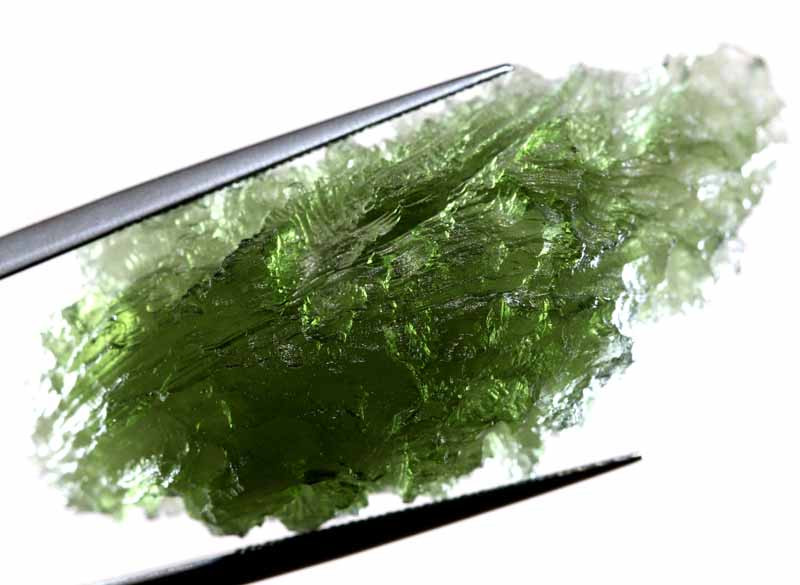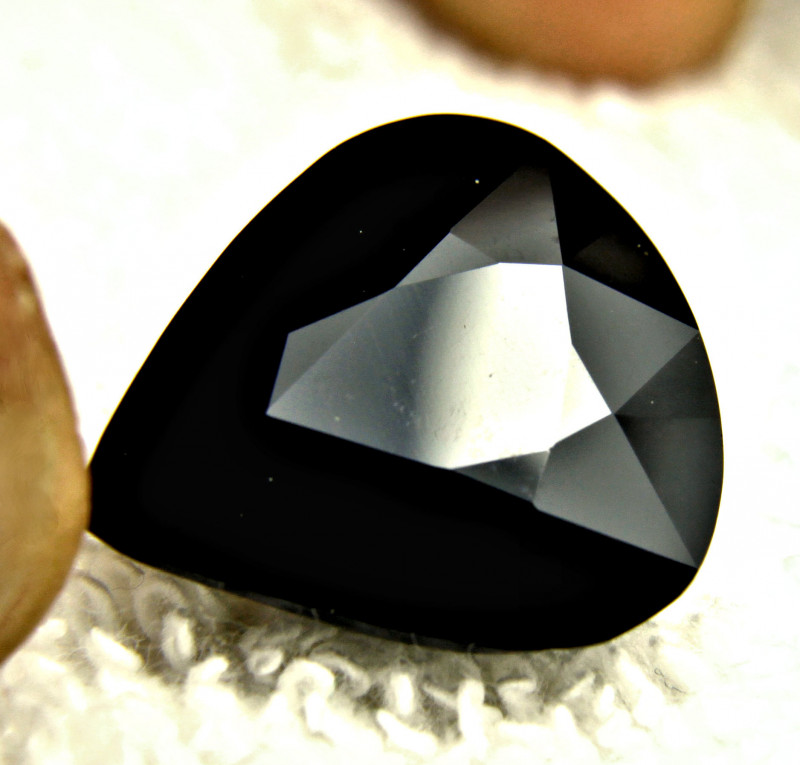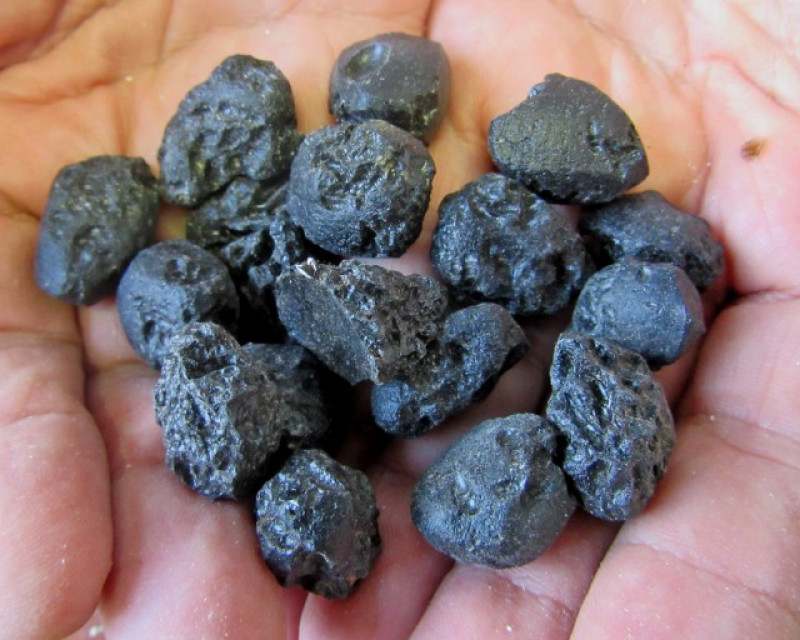
Piedra preciosa tectita: propiedades, significados, valor y más
 La tectita es un vidrio natural único y hermoso, ¡y se cree que tiene orígenes cósmicos! Las gemas de tectita se asemejan a guijarros brillantes y vítreos, y suelen ser negras, aunque también pueden ser de color marrón oscuro, gris o verde.
La tectita es un vidrio natural único y hermoso, ¡y se cree que tiene orígenes cósmicos! Las gemas de tectita se asemejan a guijarros brillantes y vítreos, y suelen ser negras, aunque también pueden ser de color marrón oscuro, gris o verde.
¿Son raras las tectitas? La tectita se encuentra en pocos lugares del mundo, lo que la hace bastante rara. Aún se sabe poco sobre estos cristales con forma de guijarro, pero su escasez y misterio aumentan su encanto.
Como su fuente de confianza para todo lo relacionado con las gemas, ¡nos complace informarle sobre todo lo que necesita saber sobre esta fascinante gema! Siga leyendo para familiarizarse con el significado, las propiedades, los usos, el valor y mucho más de las tectitas.

Acerca de la piedra tektita
Gran parte del origen de la tectita está ligado a los meteoritos, pero ¿es la tectita un meteorito ? No exactamente: es una gema semipreciosa que se dice que es el resultado de impactos de meteoritos en la Tierra y de otras teorías sobre su origen, pero hablaremos más sobre ello más adelante. El nombre de la tectita proviene de la palabra griega tektos , que significa "fundido", en referencia al calor del meteorito.
¿La tectita da suerte? ¡Claro que sí!
En numerología, la tectita está asociada con los números uno y nueve.
Aunque no está clasificada oficialmente como una piedra zodiacal o estelar, la conexión de esta gema estelar con el cosmos le permite resonar con todos los signos astrológicos. La tectita puede potenciar tus fortalezas y debilidades, sin importar tu signo zodiacal.
¡A continuación, veamos cómo identificar la tectita!
Especificaciones y características de Tektite
Las tectitas son nódulos vítreos o cristalinos irregulares, de formas intrincadas, que presentan una gama de tonos negros, grises, marrones o verdes. No se aplica un sistema cristalino, ya que la tectita es un mineraloide amorfo (no cristalino).
Es fácil confundir la apariencia física de la tectita con la de la obsidiana . Sin embargo, ¡la tectita y la obsidiana tienen composiciones químicas completamente diferentes! Se pueden diferenciar mediante el calentamiento: la obsidiana forma burbujas (debido a su contenido de agua), mientras que la tectita no (por su falta de agua).
A continuación se presenta una descripción general de las propiedades minerales de la tectita:
Fórmula : variable; Sílice (75%) + Al, Fe, Ca, Na, K, Mg, Ti, Mn
Familia de minerales : mineraloide/meteorito
Composición : Vidrio
Dureza de Mohs : 5-6,5
Color : Negro, verde, verde amarillento, marrón verdoso, marrón, incoloro.
Estructura cristalina : amorfa
Brillo : Vítreo a opaco
Transparencia : Transparente a opaco
Índice de refracción : 1,46-1,54
Densidad : 2,21-3,40
Escote : Ninguno
Fractura : Concoidea
Pleocroísmo : Ninguno
Por otra parte, la composición de la tectita puede variar según su ubicación. Dicho esto, ¡exploremos algunas de sus variedades!
Tipos de cristales de tectita
En la actualidad, el origen de las tectitas se ha reducido a cuatro campos dispersos bien definidos (o áreas de impacto de meteoritos) de diferentes edades geológicas:
Microtectitas : tectitas microscópicas de menos de un milímetro de diámetro que se encuentran en sedimentos oceánicos y hielo polar.
Tectitas Muong-Nong (o estratificadas) : reciben su nombre del lugar donde se encontraron (Muong Nong en Laos, Vietnam) y su tamaño varía de centímetros a decímetros. Este es el único grupo de tectitas que se encuentra en tierra.
Tectitas en forma de salpicadura : “en forma de salpicadura”, lo que significa que se formaron por material fundido salpicado por impactos; generalmente tienen forma de esferas, elipsoides, lágrimas, discos o mancuernas.
Tectitas ablacionadas : formadas a medida que las partículas sólidas salpicadas reingresan a la atmósfera a altas velocidades y se vuelven a fundir parcialmente.
 Imagen: variedad de tektita moldavita
Imagen: variedad de tektita moldavita
Variedades de tectita
Entre las categorías principales se encuentran diferentes variaciones de tectitas, muchas de las cuales reciben su nombre según su ubicación. Si bien algunas variedades son más comunes que otras, todas están relacionadas, pero su composición varía.
Variedades populares:
Australita
La australita es una variedad de tectita oscura, a menudo negra, del campo disperso de Australasia (cráter de impacto del sudeste asiático) y se cree que tiene entre 0,77 y 0,78 millones de años.
Bediasita
La bediasita, otra variedad negra, proviene del campo disperso de América del Norte (cráter de impacto de la bahía de Chesapeake) en Texas, EE.UU.
Vaso de Darwin
El vidrio de Darwin (o darwinita) es una variedad de color verde claro a oscuro, blanco o negro, procedente de Tasmania, Australia.
Georgiaita
La georgita es una tectita amarillenta, verde, a veces azul, del campo disperso de América del Norte (cráter de impacto de la bahía de Chesapeake) en Georgia, EE. UU.
La moldavita tectita es una variedad de tectita de color oscuro a claro, de azul a verde, procedente del cráter Nördlinger Ries, en el sur de Alemania. Se cree que tiene más de 15 millones de años.
filipinita
Como su nombre lo indica, la filipina es una variedad oscura procedente de Filipinas. Se cree que la filipinita tiene unos 710.000 años de antigüedad.
Zhamanshinita
Este es el nombre que recibieron las tectitas del cráter de meteorito Zhamanshin hace aproximadamente un millón de años.
Variedades menos conocidas:
Bikolita
Bikolite es una variedad de la zona de Bikol en Filipinas.
Billonita
La billonita es un material tectita procedente de la isla Billiton (entre Sumatra y Borneo).
Chinita
La chinita es una tectita negra, también procedente del campo disperso de Australasia. Se encontró en China, de ahí su nombre.
Indochinita
La indochinita es una variedad oscura, mayormente negra, que se encuentra predominantemente en el Sudeste Asiático y Australia, y posiblemente en Canadá. Se cree que el cráter de este campo disperso se encuentra en el sur de Laos.
Irghizita
La irghizita es una variedad procedente del cráter de meteorito Zhamanshin en Kazajstán.
Ivorita
La ivorita es una variedad negra procedente del campo disperso de Costa de Marfil (cráter del lago Bosumtwi, Ghana). Se encuentra en Costa de Marfil.
Uruguayo
Un descubrimiento más reciente, la uruguaíta, es una variedad negra procedente de un nuevo campo descubierto en 2016.
Ufff. ¡Son muchísimas tectitas!
¡Cambiemos de tema y veamos cómo ha aparecido esta joya de otro mundo a lo largo de la historia!

Significado e historia de la tectita
Durante siglos, el significado y el origen de la tectita han estado rodeados de misterio en el mundo de la geología.
La primera mención registrada de la tectita proviene de China durante la dinastía T'ang en el año 900 a. C. Proviene de un libro de Liu Sun (un prolífico autor chino) con un título que se traduce libremente como "Notas sobre las maravillas más allá de las montañas Nanling en Kwangtung".
Sun habla de recolectar lei-gong-mo , o tinteros de los Dioses del Trueno, después de las tormentas. Describe estos objetos como piedras negras y brillantes que resonaban al ser golpeadas.
Después de esto, la tectita pareció pasar desapercibida hasta finales del siglo XIX y principios del XX. Por aquella época, el investigador parisino Alfred Lacroix descubrió un gran yacimiento de tectita en Indonesia, y poco después en Costa de Marfil. Estos descubrimientos, junto con la investigación publicada por Lacroix, despertaron un mayor interés científico por la tectita en todo el mundo.
Los científicos dedicaron la primera mitad del siglo XX a localizar e identificar nuevas tectitas y sus ubicaciones en todo el mundo. A medida que se descubrieron más depósitos, surgieron numerosas hipótesis sobre el origen de las propiedades químicas y físicas únicas de las tectitas.
En las décadas de 1950 y 1960, la investigación sobre tectitas adquirió relevancia debido a su supuesto origen lunar. Aunque esta teoría fue finalmente desacreditada, los datos recopilados sentaron las bases de gran parte de la investigación sobre tectitas que se lleva a cabo en la actualidad.
Continuando, ¿para qué se utiliza una piedra preciosa tectita en términos de curación?

Propiedades curativas de la tectita
Todos los cristales poseen propiedades metafísicas que los convierten en piedras curativas . Se cree que la tectita es una poderosa herramienta de sanación debido a sus conexiones con el universo. Su energía cósmica proporciona una multitud de poderes de sanación física, emocional y espiritual.
¡Veamos cómo puedes aprovechar la energía de la tectita para restaurar tu mente, cuerpo y espíritu!
Curación física
La tectita puede ser un sanador físico excepcional. Puede acelerar la curación de lesiones o enfermedades, mejorar los problemas circulatorios y favorecer la fertilidad.
¿Odias ese pre-entrenamiento que te tomas a toda prisa antes de ir al gimnasio? Usar Tektite puede hacerte sentir más fuerte físicamente y ayudarte a recuperarte más rápido. ¡Hola, nuevo récord personal!
Sanación emocional
Al igual que los beneficios físicos, usar una tectita puede fortalecerte mentalmente. Puede ampliar tu visión y afinar tu concentración para ver el panorama general.
Como vehículo de exploración telepática, puede mejorar sus habilidades psíquicas y estimular los viajes astrales o los sueños lúcidos.
¿Necesitas un talismán de escritorio para impulsar tu productividad? La tectita puede ayudar a fomentar el conocimiento, mejorar la memoria e inspirar motivación. Su energía inspiradora también resuena con las personas creativas.
Sanación de chakras
Las piedras de chakra contienen energías especiales sintonizadas con uno o más puntos energéticos (chakras) a lo largo del centro del cuerpo. Sin embargo, las vibraciones intergalácticas de la tectita pueden aplicarse en cualquiera de ellos para potenciar las características óptimas de ese chakra.
Por ejemplo, puedes colocar tectita en la coronilla (superficie de la cabeza) para buscar claridad y expansión mental. Si deseas mejorar tu visión clarividente, puedes colocar tectita en el tercer ojo (frente, entre los ojos).

Propiedades de la piedra preciosa tectita
El valor de las tectitas depende de muchos factores estándar de otras gemas: color, corte, claridad y tamaño, con algunas variaciones menores.
Color
La mayoría de las tectitas son opacas con variaciones de color oscuras. Las gemas translúcidas y más claras suelen alcanzar precios más altos debido a su oscuridad. Sin embargo, los colores oscuros siguen siendo codiciados.
Cortar
La dureza moderada de la tectita puede dificultar su corte. Los lapidarios expertos pueden tallarla en formas populares, como cojines y cortes de fantasía, así como en formas sin tallar, como cabujones o tallas decorativas.
La tectita en bruto también es popular para joyería y exhibición. El valor de los especímenes en bruto varía según su forma, tamaño y atractivo visual.
Claridad
Es bastante común que las gemas de tectita presenten inclusiones de burbujas redondeadas o con forma de bala y líneas o crestas en espiral. Estas inclusiones no parecen afectar el precio, sino que son una cuestión de preferencia.
Peso y tamaño en quilates
Puedes medir la tectita en quilates, gramos o milímetros indistintamente.
La mayoría de los especímenes son bastante pequeños (entre 1 y 5 gramos). Los especímenes de tectita de mayor tamaño son raros.
Tratos
Aunque la tectita no suele someterse a tratamientos , los vendedores pueden mejorar su acabado brillante mediante un pre-aceite (pulido con aceite mineral o de cedro). Este tratamiento no afecta el valor de la tectita ni sus supuestas propiedades curativas.
Entonces, ¿cómo se forman las tectitas?

Orígenes y fuentes de la tectita
¡Aún queda mucho por descubrir sobre las tectitas! En cuanto a su origen, se han barajado varias teorías, desde explosiones atómicas hasta rocas lunares. Sin embargo, la mayoría de los investigadores creen que los meteoritos tienen la respuesta.
¿Es la tectita un meteorito? Actualmente, la teoría principal es que la tectita se forma a partir de meteoritos.
Según los científicos, la tectita es un vidrio fundido causado por el impacto de un meteorito en la Tierra. Este impacto genera un calor y una presión enormes. El material terrestre (roca, sedimento, etc.) se fundió con el impacto, se elevó al aire y volvió a caer a la Tierra, enfriándose y formando los nódulos vítreos, similares a guijarros, que ahora conocemos como tectitas.
Ubicaciones mineras
¿Dónde se encuentran las tectitas? ¡En varias zonas del mundo! Se pueden encontrar tectitas en:
Australia
Porcelana
República Checa (moldavita)
África del Noroeste
Tailandia
Estados Unidos
Vietnam
¿Te intrigan estos restos terrestres? ¡Veamos cómo se venden estas joyas!

Precio y valor de Tektite
¿Son caras las tectitas? Los precios pueden variar según dónde se compren. En los lugares donde abunda la tectita, los precios son más bajos, y su valor aumenta a medida que se aleja de la fuente.
A continuación se muestra una breve instantánea de los precios aproximados (por gramo) que alcanzan las variedades más comunes de tectita:
Australitas : calidades típicas: de $1 a $10 por gramo; calidades superiores: de $30 a $50 por gramo y hasta más de $1000
Bornitas : más esquivas; cuestan unos 2 dólares el gramo.
Billitonitas : entre 1,5 y 2 dólares por gramo
Vidrio Darwin : de 1 a 1,5 dólares por gramo; formas salpicadas y mejores formas, de 2 a 7 dólares por gramo.
Georgianos : alrededor de 100 dólares por gramo
Indochinitas — Calidades típicas: de $0,1 a $0,7 por gramo; calidades superiores: $1 por gramo
Irghizites : alrededor de 2 dólares por gramo
Ivorites : entre 100 y 300 dólares por gramo
Moldavitas — Grados típicos: $11 a $13 por gramo; Grados superiores: $16 a $22 por gramo
Filipinos : Grados típicos: de $0,2 a $1,0 por gramo; Grados superiores: de $3 a $5 por gramo
Uruguayos — Más de 100 dólares el gramo
Zhamanshinites : alrededor de $0,15 a $0,30 por gramo
¡Ahora que ya sabes cómo se adaptan las tectitas a tu presupuesto, esta es la mejor forma de garantizar que tus gemas mantengan su belleza y sus poderes metafísicos durante los próximos años!
Cuidado y mantenimiento de Tektite
No se deje llevar por la dureza moderada de la tectita; este cristal aún es susceptible a rayones y roturas accidentales, por lo que es esencial un cuidado adecuado .
Para limpiar su tectita, simplemente use un cepillo suave, jabón suave y agua tibia.
Evite que su tectita entre en contacto con:
Productos químicos/ácidos agresivos
Limpiadores a vapor
Limpiadores ultrasónicos
Impactos más fuertes
Cambios extremos de temperatura
En cuanto a la joyería, sus anillos de tectita deben tener engastes protectores . Solo debe usarlos ocasionalmente. Otras joyas, como colgantes y aretes, no deberían ser un problema.
Guarde su tectita en una bolsa suave o en una caja forrada de tela, lejos de gemas más duras.

¡Alcanza las estrellas con Tektite!
¡La tectita es mucho más que vidrio fundido! Su apariencia única es suficiente para llevar tu colección de gemas a las alturas lunares. Si esto no te convence, la energía cósmica de la tectita y sus vínculos con los cielos elevarán tu felicidad y expandirán tu mente con su magia extraterrestre.
¿Listo para despegar con la tectita? ¡Compra gemas de tectita hoy mismo!
Buscar en el Gemstone Encyclopedia
Subastas relacionadas
Artículos relacionados
Cada persona tiene una piedra preciosa que corresponde a su signo zodiacal. Estas también se conocen como tu Piedra Estelar. Aprende más sobre estas piedras y descubre cuál es tu Piedra Estelar.
10th May 2018
Originalmente, las piedras de nacimiento o gemas se asociaban con un signo zodiacal o el mes de nacimiento de una persona. Descubra cuál es su piedra y vea las que tenemos a la venta.
8th Feb 2021
Hay docenas de gemas de cuarzo y calcedonia con diversos colores y patrones. ¡Aprenda todo sobre las propiedades del cuarzo y cada tipo de cuarzo, desde la amatista y el ágata hasta el cuarzo plasma y el cuarzo fantasma!
15th Oct 2020
últimos artículos
Las tallas de marfil de palma, también llamadas marfil vegetal, son una alternativa natural al marfil de elefante, extraído éticamente de la nuez de palma de la palmera sudamericana Phytelephas. ¡Aprenda todo sobre el marfil de palma en esta guía!
15th Jan 2026
Las piedras de flores de crisantemo son maravillas naturales que presentan un patrón floral de calcita blanca, celestita o andalucita sobre piedra caliza negra o lutita.
13th Jan 2026
La piedra solar reticulada arcoíris es una variedad de feldespato con tres magníficos efectos ópticos causados por la presencia de diversas inclusiones. Su vibrante colorido y su patrón reticular la convierten en una rara joya de colección.
12th Jan 2026
Categorías de artículos
How To's is where you will find helpful articles from gem Rock Auctions on how to cut gemstones, select gemstones and buy gemstones.
9 Artículos


![MASSIVE BRECIATED MOOKAITE 298 GRAMS [[MX928 ]](https://liveplatforms-production.b-cdn.net/tenants/gr/uploads/images/75000-79999/75508/75508_1233708971.jpg?width=480&aspect_ratio=1001%3A1000)

![MASSIVE FLUORITE GOLD -BRILLIANT COLOURS 135 CTS [S2199]](https://liveplatforms-production.b-cdn.net/tenants/gr/uploads/images/50000-54999/51509/51509_1222410585.jpg?width=480&aspect_ratio=1001%3A1000)
